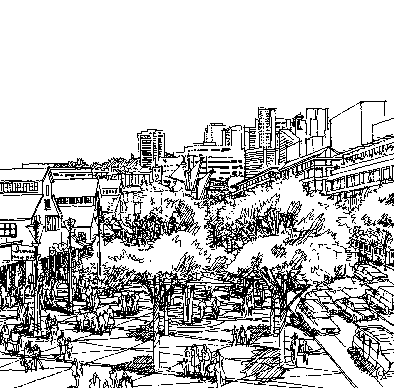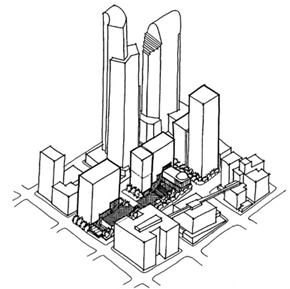
Urban Development
DJC.com
Next >
Back <
Good urban design reflects
the essence of a community
"The importance of creating civic design conscience, and therefore doing real urban design, is probably more critical today than at any time in Seattle's history." -- John Rahaim, CityDesign
By LEE COPELAND
Weinstein Copeland
Urban design addresses the quality of one's experience in the environment. It includes functional aspects of accommodating building programs, circulation infrastructure and the landscape, issues of comfort, safety and accessibility, and elements of a more subjective nature. But of equal importance, it also includes the achievement of beautiful, inspiring environments. The foundation upon which urban design is conceived is community goals, the expression of a community's aspirations.

|
Fortunately for Seattle, there is a community of architects, landscape architects and urban planners and our Mayor who consider urban design an integral part of their practice and responsibility.
In the summer 2000 issue of Arcade, John Rahaim, executive director of the Seattle Design Commission and CityDesign, the city's office of urban design, wrote: "The importance of creating civic design conscience, and therefore doing real urban design, is probably more critical today than at any time in Seattle's history."
Rahaim sees urban design as the product of a civic design conscience which he defines as a "belief that there is as great a value to the design of the public realm, that civic place we all share, defined in the city by streets, open spaces and the buildings that front on them, as the design of the latest high-rise. It is the belief that the design of the connections between places and between neighborhoods, or between the Sound and the Lake, is as important as the design of the Sculpture Park and the Opera House that lie in that path."
A "city" is defined as a town of importance. The root, "civitas" embodies both the place and its inhabitants or citizens. As urban designers, we are concerned especially with the quality of the public realm, for creating places to support and encourage public life, places where citizens live and value a sense of community.
Places facilitating public life include our streets, parks, schools, community centers, libraries, churches, recreation fields and sports arenas, theaters and performance halls, shopping of all kinds, public transportation and Seattle Center. These places provide environments and activities where people, often strangers to each other, come together in comfort. A healthy city requires places of privacy and seclusion, semi-private or semi-public environments such as one's own block as well as these places of public life.
One of the goals urban designers strive for in their work is the attainment of a strong "sense of place." Seattle, as we all know, embodies the meaning of a sense of place. We are located in the northwest corner of our country, on the edge of the Pacific Rim on a threshold between the Pacific Ocean and the interior, not meandering between.
Other unique attributes which we value and consider as part of the palette we work with include our topography, views to the water, mountains and sunsets, our natural environment, our quality of light and our temperate climate.
When we take these qualities into consideration in the design of places in Seattle, we strengthen the uniqueness of our sense of place here.
Our practice, Weinstein Copeland Architects, in association with Hewitt Architects developed the new Civic Center Plan for our city last year. The urban design concept for the center embodies many of these attributes.
The open space is configured to stretch over two blocks between Fifth and Third, cascading down the hill and celebrating the topography. This space will be a place of public gathering, a place for speech making, receiving guests, for music, for demonstrations or for having coffee with a friend. It is a place, open to the south, to receive the sun and afford views to the west.
The new City Hall will provide a back drop and definition to the space, with its entrance, public activities and services, and the City Council chambers open to and accessible to the public open space. The concept for the open space includes a garden and water. The garden should require maintenance, as do our residential private gardens, symbolizing caring by the city and its citizens for our environment.

|
In the plan for New Holly, we sought to integrate this neighborhood into the surrounding community by linking to the existing street system and structuring the block to make it similar to the surrounding grid. We have also established a hierarchical, comprehendible structure of open spaces that includes public community parks, a community center and library, intimately scaled semi-public residential streets and alleys (this is mine and my neighbor's block) and houses with porches.
Porches have traditionally been a semi-private transition from the street to the private realm of the house, a place for casual socializing among neighbors or simply providing eyes on the street, and private rear yards. There has been a conscious effort in the design of New Holly to create a new sense of place and provide and clarify places for public, community life while respecting the need for privacy and a sense of territory as well.
In this time of growth and prosperity, what can we do to further strengthen the quality of our public environment while achieving a unique and appropriate sense of place?
For the past six months a group of us including Lesley Bain with Weinstein Copeland, Jeff Benesi with Hewitt Architects, and Dennis Haskell with Parsons Brinckerhoff Quade Inc. have been studying ways of improving our central waterfront.
We have approached this with the goal of realizing our waterfront as the public threshold to our city, to provide a place and space for public life integrated and linked to our downtown and surrounding neighborhoods. To recapture what is perhaps our most unique and valuable asset, the connection of our city to our shoreline, we must remove the greatest impediment to that realization, the Alaskan Way Viaduct.
Many other port cities made the same mistake we made, constructing viaducts or freeways on the shore, and have recently corrected their mistakes: Portland, San Francisco and Boston, for example. New York refused a proposed viaduct a few years ago.
By removing ours we will be able to realize a significant public promenade and park on the waterfront, additional new development better suited to linking the waterfront to the upland downtown and opportunities to create strong pedestrian ties from the waterfront to the downtown, Belltown, Pioneer Square and the sports venues to the south.
We are fortunate to live in Seattle where the urban and natural environment are mutually supportive and clearly effect our way of life. As urban designers we have the challenging and wonderful responsibility to understand the essence of this place and express and celebrate this understanding in the design of our environment.
Lee Copeland is a partner in the Seattle architecture firm of Weinstein Copeland.
Top | Back | Urban Development | DJC.com Copyright ©1995-2000 Seattle Daily Journal and djc.com.
Comments? Questions? Contact us.